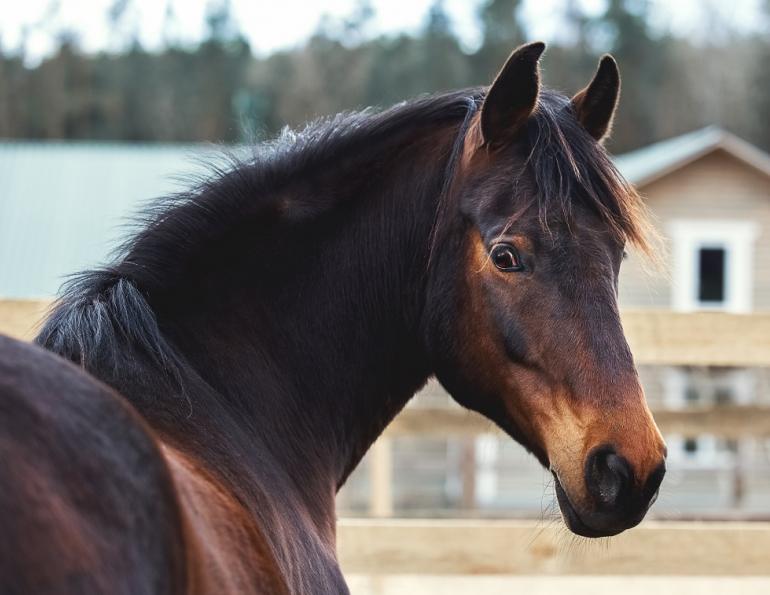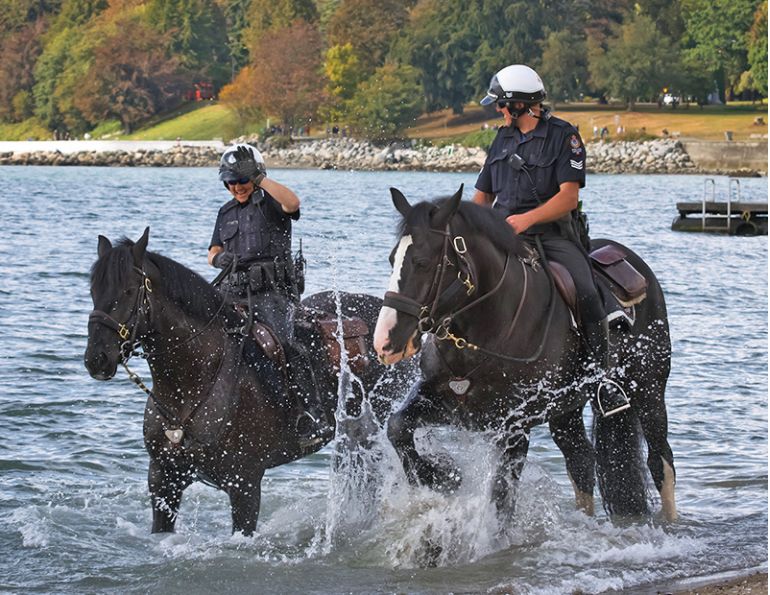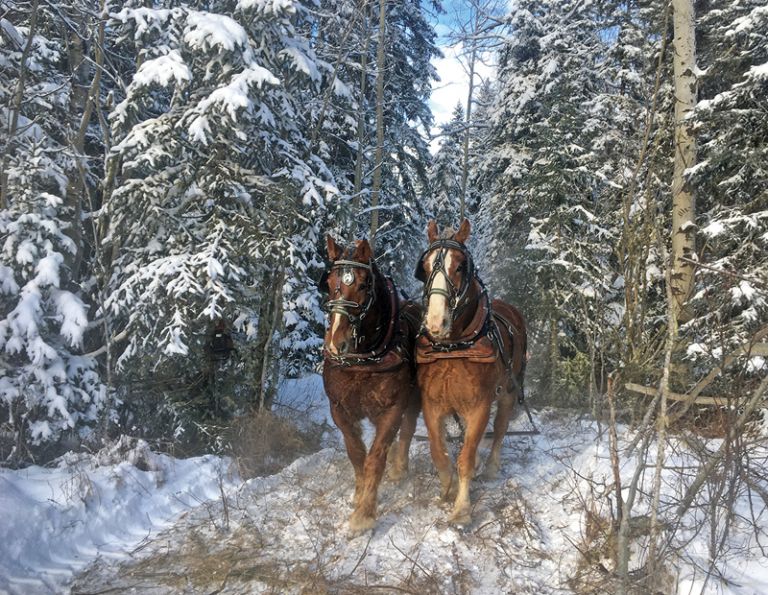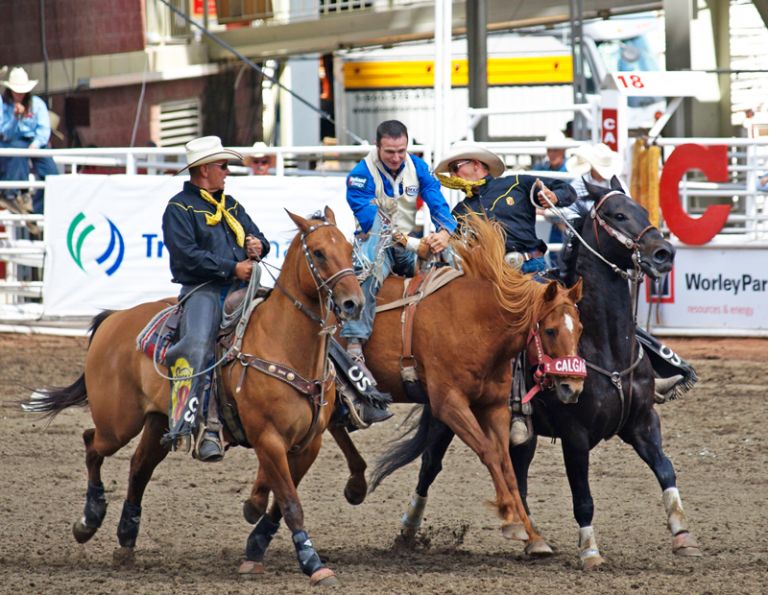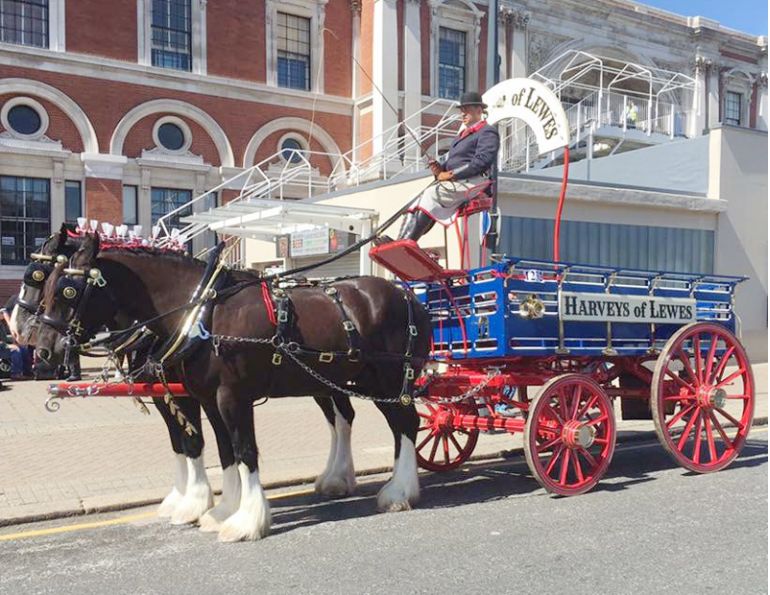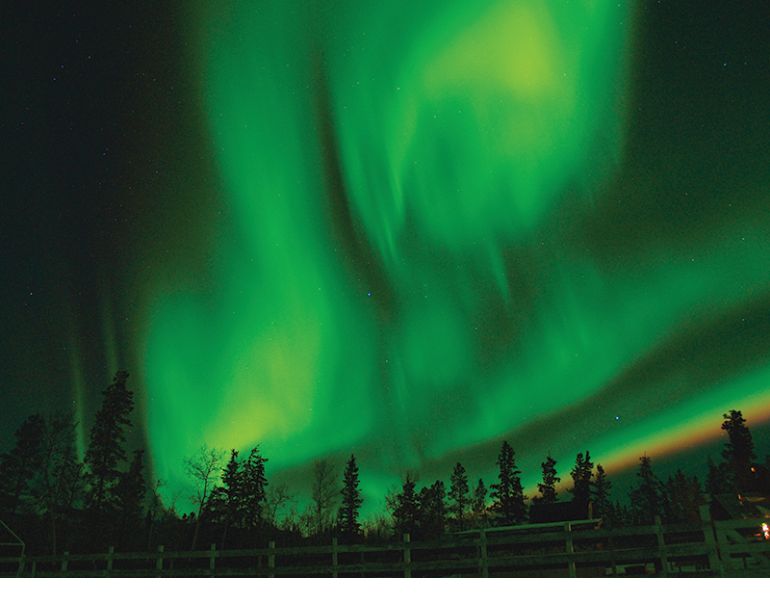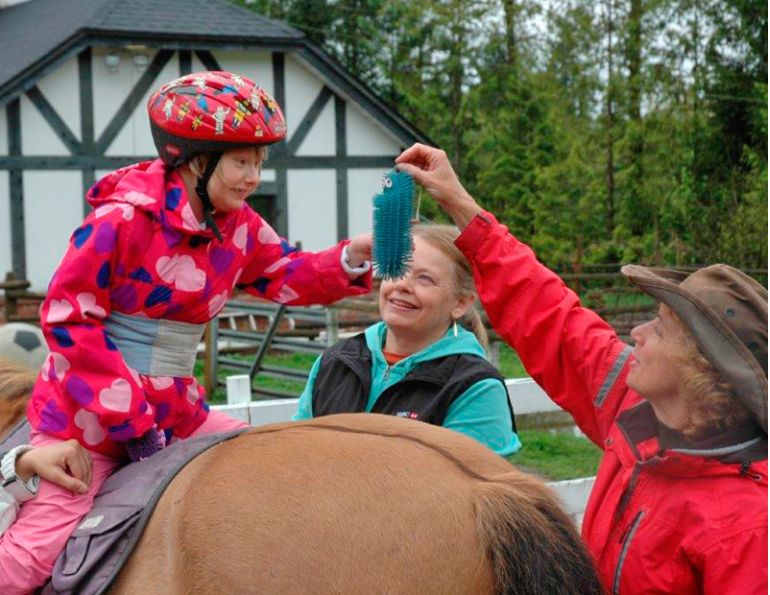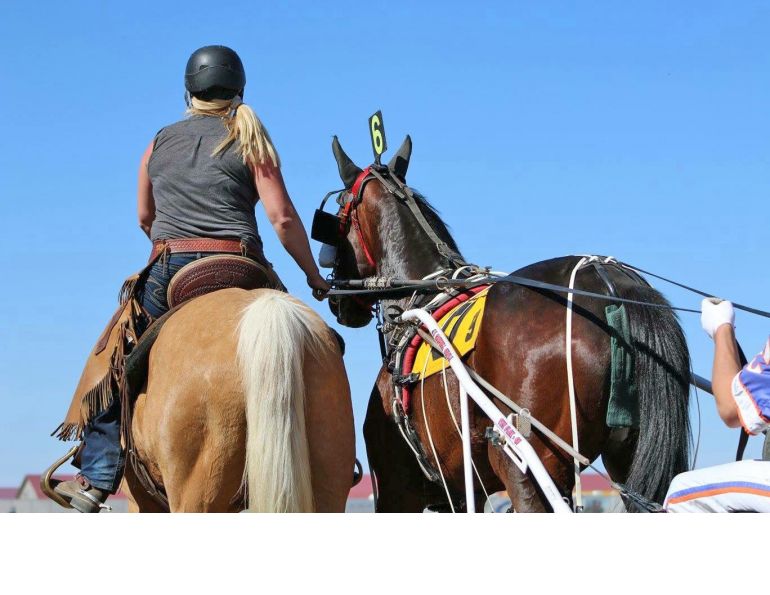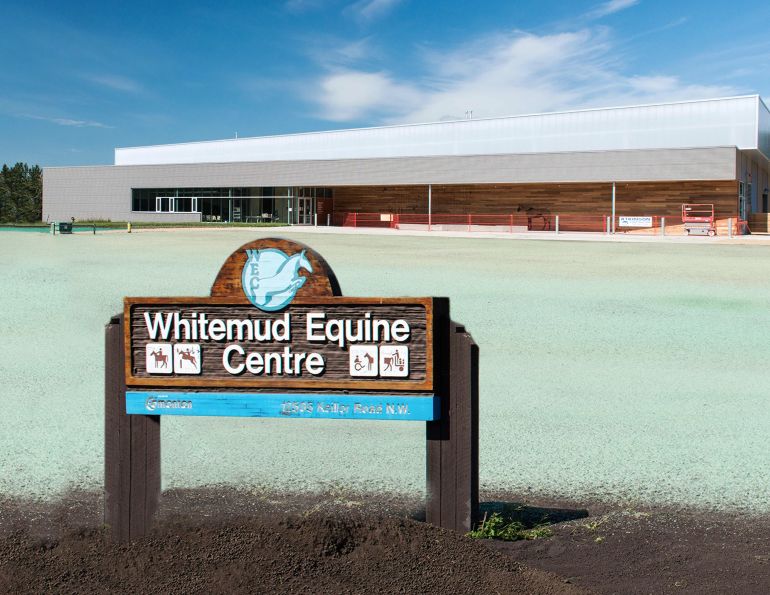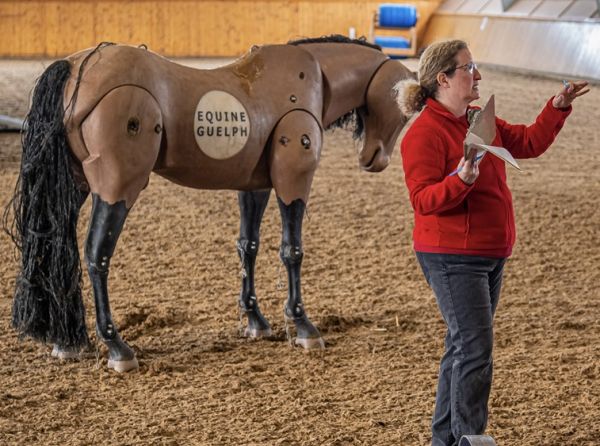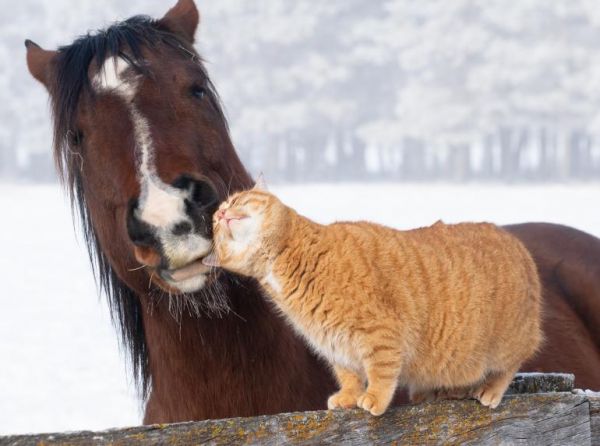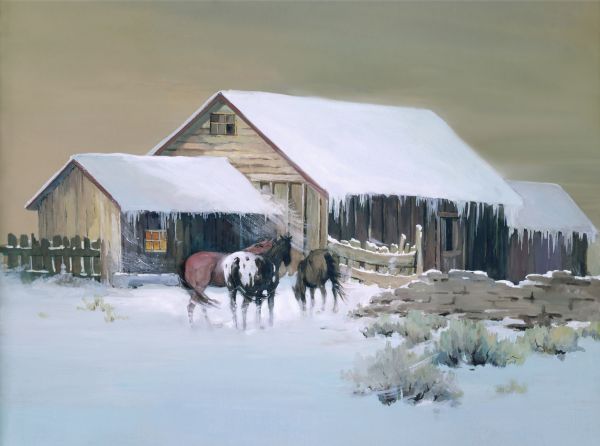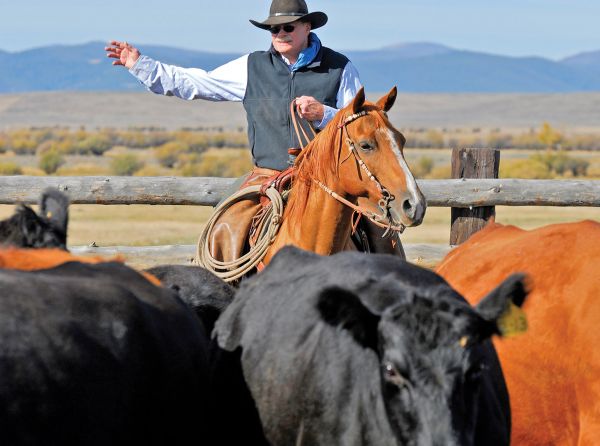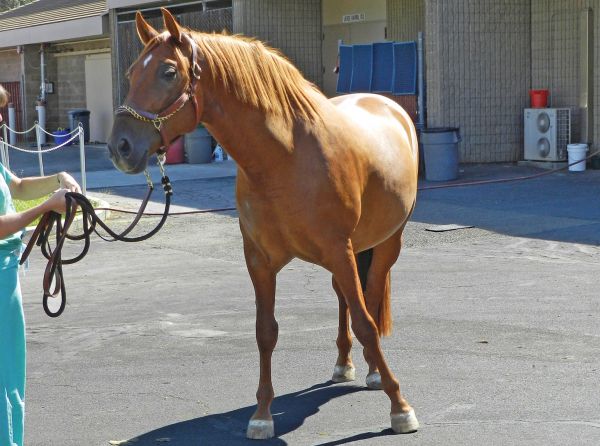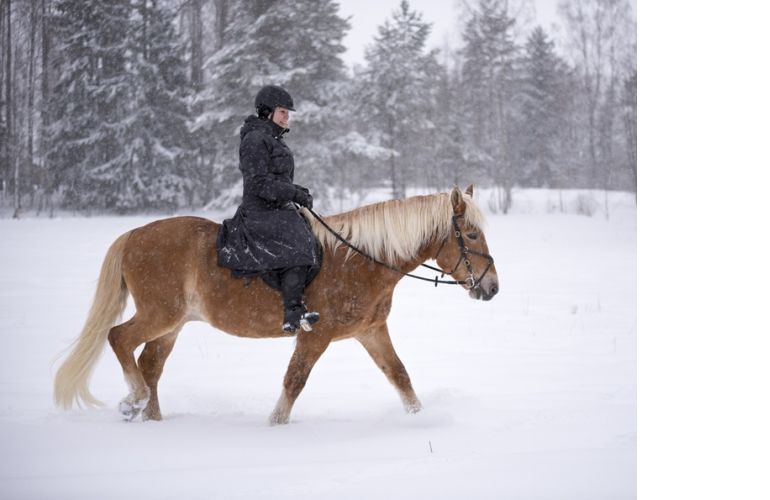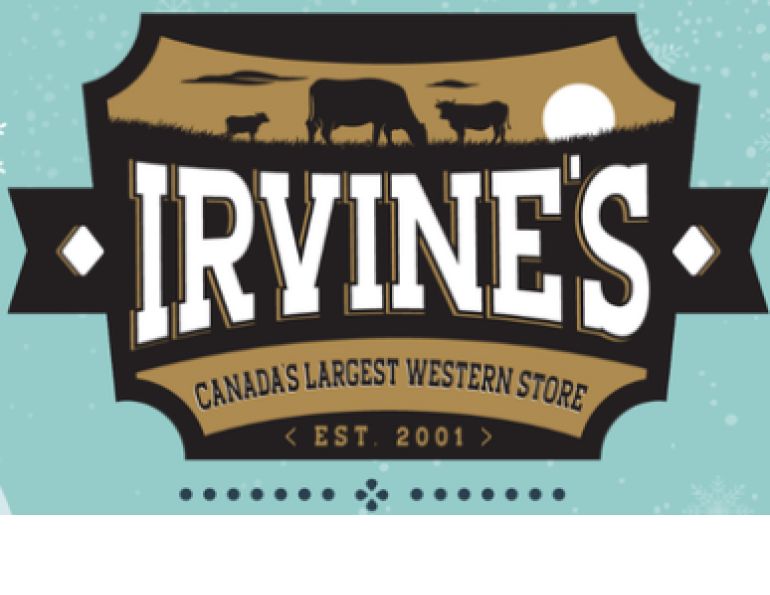By Margaret Evans
From pony cart to coronation coach, few vehicles have had such a colourful history as the horse-drawn carriage.
Ever since the wheel was first invented around 3,500 BC in Mesopotamia as a wooden disc with a hole in the middle for some form of axle, creative Sumarian minds were buzzing. They were, after all, already planting crops, herding animals, and had a pretty impressive social order. But getting the wheel contraption right took a bit of creative genius. The holes in the centre of the disc and at the ends of the axle had to be perfectly smooth and round in order for the wheel to fit and turn. Otherwise, too much friction would cause breakage.
The wheel for transportation actually followed the invention of the potter’s wheel. But those Bronze Age inventors wasted little time connecting the dots and figuring out that if you put a box on top of the axle, you’d have a cart. It you hitched a horse to the front end, you’d have an animal to pull it which would save doing it yourself. With the domestication of the horse almost 6,000 years ago, a marriage between the cart and the horse was inevitable, eventually transforming a civilization. On the Sumerian Battle Standard of Ur is the depiction of an onager-drawn cart from 2,500 BC.
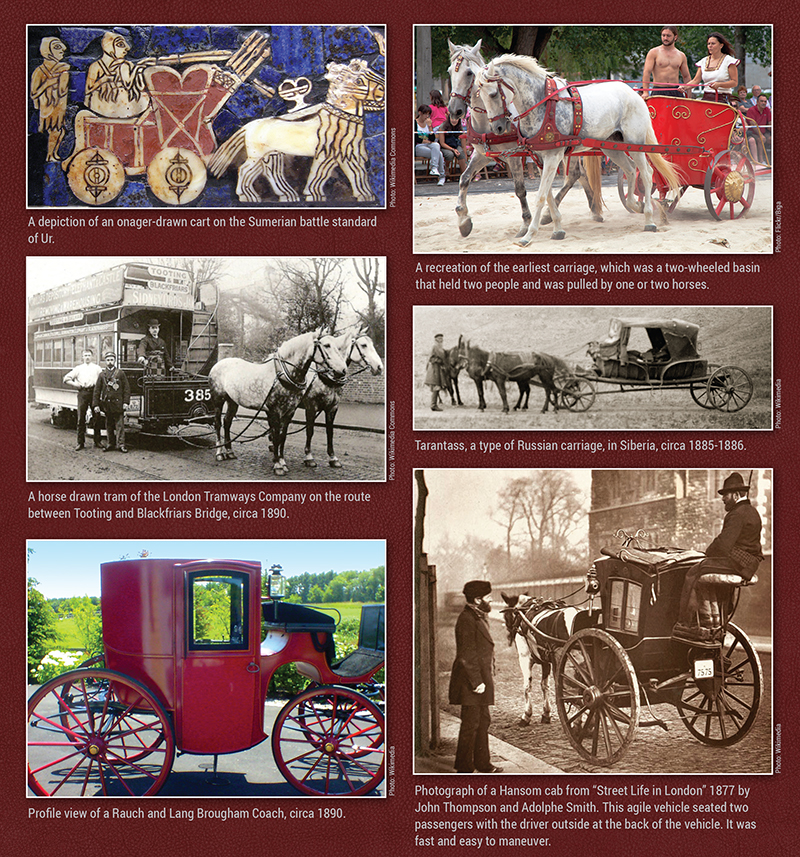
The earliest form of a “carriage” (from Old Northern French meaning to carry in a vehicle) was the chariot in Mesopotamia around 3,000 BC. It was nothing more than a two-wheeled basin for a couple of people and pulled by one or two horses. It was light and quick and the favoured vehicle for warfare with Egyptians.
Carriages in a myriad of formats quickly became the defining form of transport. And with them came their own dictionary of terms. A carriage is sometimes called a team. A carriage and horse is a rig. A carriage with horses, harness, and attendants is a turnout. A procession of carriages is a cavalcade. Then there’s the coachman (driver), footman (who cleared the path in front), a carriage starter (directing the flow of carriage traffic at curbside), and a hackneyman (hiring out carriages). Horses were carriage horses (for the wealthy and elite) or road horses (a working horse for the road). They were kept in stables or, among royalty and aristocracy, in mews, so named because the buildings originally housed birds used for falconry and their cyclic moulting of feathers was known as mewing. The mews contained not only stabling for the horses, but a carriage house and housing for staff. The most famous is the Royal Mews on the grounds of Buckingham Palace.

Of the more than 100 historic coaches and carriages housed at The Royal Mews at Buckingham Palace, the coach most often employed is The Irish State Coach, used for the State Opening of Parliament. Photo: Robert Sharp/Wikimedia Commons
Over the centuries, a bewildering array of carriages entered mainstream. They were developed not only for the practical needs of getting around and delivering goods, but for style, elegance, and changing fashions. From a barouche to a chaise, governess cart, dos-a-dos, Hansom (named after Joseph Hansom who designed and patented it in England in 1834), Landau (named after the German city of Landau where they were first made), road coach, tarantass, or a simple village cart, there was always something practical to hitch a horse or pony to.
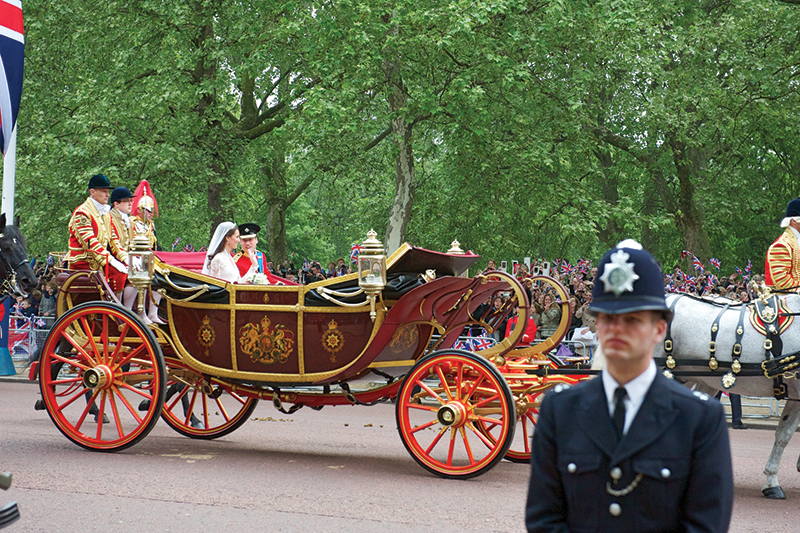
The 1902 State Landau carriage carrying Prince William and Kate Middleton from their marriage. Photo: John Pannell/Flickr/Wikimedia Commons
In 1829 in England, the horse-drawn hail-and-ride bus was launched, followed much later in 1870 by horse-drawn trams on rails. Businessmen got around town in stylish Hansom cabs, which seated two inside while the driver sat outside and at the back of the vehicle. The little cab was fast, nimble, and could turn on a dime.
Eventually, of course, motorized transportation eclipsed the horse-drawn carriage except for the most ceremonial of events. And Britain has a wealth of historical ceremonial coaches ready for hitching.
Related: Salute to Saddle Makers
At the far end of the coach spectrum is the Gold State Coach (aka the coronation coach), gorgeous to look at, but murder to ride in. This four-ton gilded coach covered in gold leaf and painted panels was built in 1762 and is drawn by eight horses, four of which are mounted by the postilion riders. Due to its weight, the carriage can only be pulled at a walk. The coach is suspended from braces and lacks absolutely any modern comfort. In fact, the ride is so uncomfortable that King William IV, a former naval officer, said it was like being “tossed in a rough sea.” King George VI said it was one of the most uncomfortable rides he’d ever had in his life.
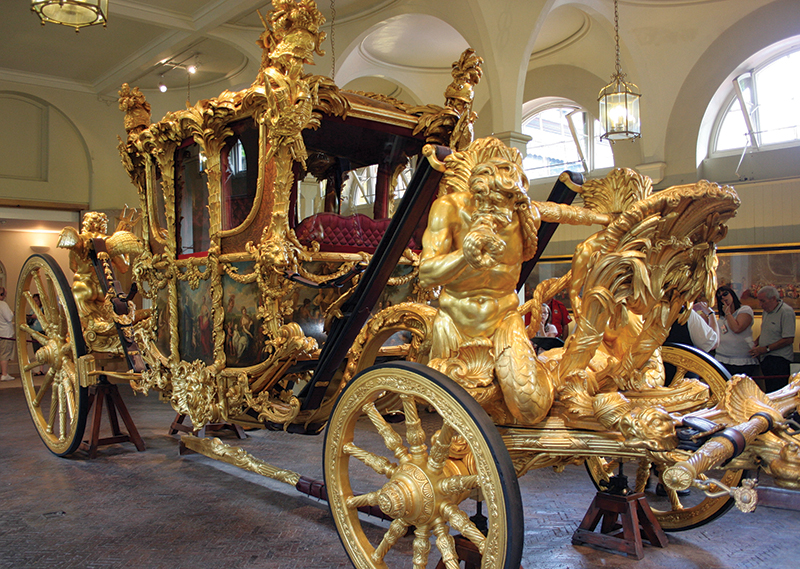
Photo: David Crochet/Wikimedia Commons
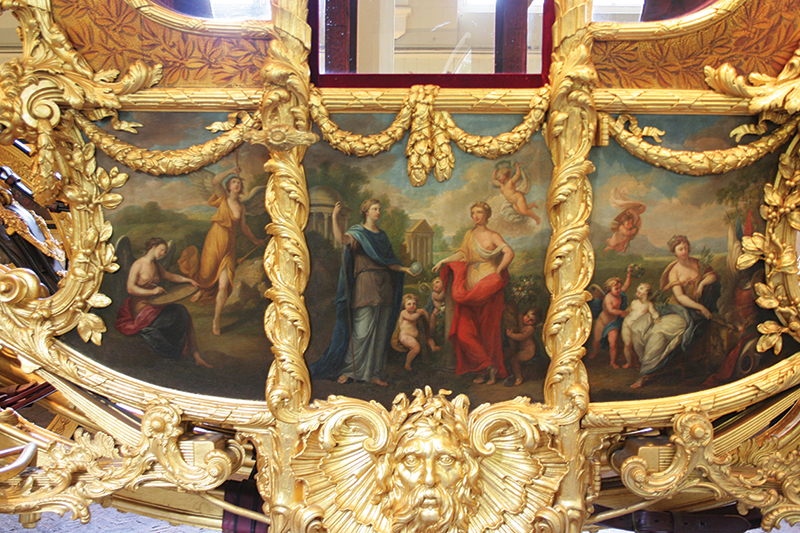
Photo: David Crochet/Wikimedia Commons
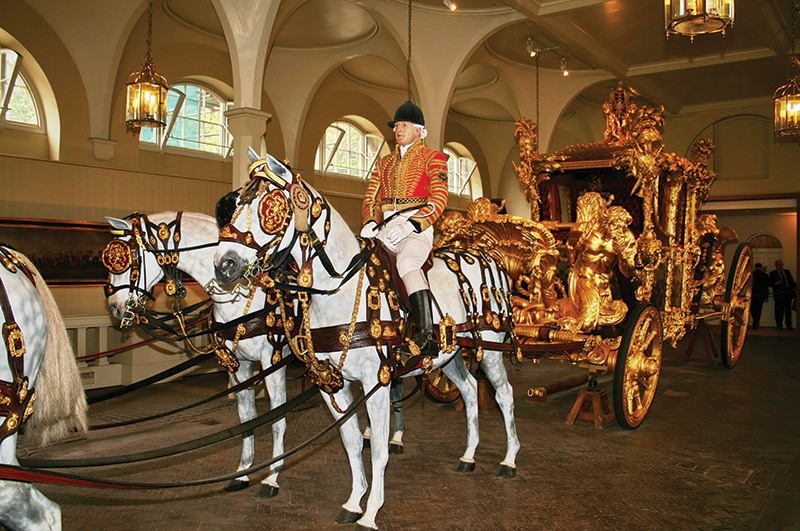
Photo: Steve F-E-Cameron/Wikimedia Commons
The Gold State Coach (Coronation Coach) gilded and painted by Italian painter and engraver, Giovanni Battista Cipriani, in 1762.
The Royal Mews at Buckingham Palace houses a collection of over 100 historic coaches and carriages, most of which are used for a variety of ceremonial and special occasions. The coach that is often used is the Irish State Coach for the State Opening of Parliament, but other state coaches include Queen Alexandra’s State Coach (used to convey the Imperial State Crown to Parliament for the State opening), the Australian State Coach (a gift to the Queen from the people of Australia on the nation’s bicentenary), the Glass Coach (a favourite of royal brides) built in 1881, and a variety of State and semi-State Landaus. All the carriages and coaches receive maintenance from craftsmen in the Royal Mews. Then there are a variety of barouches, broughams (used each day to carry messengers on their official rounds in London), and Queen Victoria’s ivory-mounted Phaeton (used by The Queen since 1987 for her birthday parade).
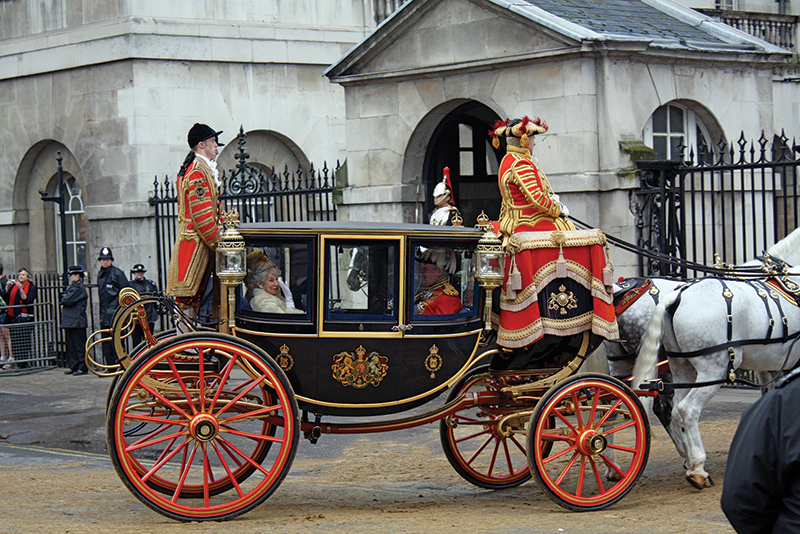
The Glass Coach, built in 1881, returning the Ladies in Waiting to Buckingham Palace after the State Opening of Parliament, 2008. Photo: Robert Sharp/Wikimedia Commons
Carriages represent a time gone by, a slower, more stately era when horses were central to everything people did and everywhere they went. Today in noisy, vehicle-cluttered cities, a ride in a horse-drawn carriage is a unique step back in time to that distant heritage – and a step forward in an unrealized appreciation for the skilled, dependable harness horse.
While horse and carriage rides have traditionally been tours around city parks, carriage operators also offer their unique services for weddings, festive and ethnic occasions, parades, movie shoots, and funerals. Each has its special needs and the horses used in harness must match those needs, often down to matching colours. Most frequently, draft horse breeds are used for carriage work and the most popular are Percheron, Belgian, and Clydesdale, as well as the lighter Friesian. But when cars, trucks, planes, and trains took over people’s lives, unknown thousands of carts, coaches, and carriages languished in barns. Some folks, though, saw value in restoring and preserving that lost time. Often it would take just the simplest task to spark a lifelong passion.
“Don Remington’s interest in carriages started in the fall of 1954 when he was in charge of the Rotary Christmas event which involved bringing Santa into town at the end of November to open the Christmas shopping season in Cardston,” says Howard Snyder, manager of Remington Carriage Museum, Alberta Culture and Tourism. “He said it was wrong to bring Santa into town sitting on a bale of hay in the back of a pickup truck. Santa should be in a sleigh. So Don found one in Marysville, British Columbia, and restored it to bring Santa into town. That began a 33-year career of collecting and restoring carriages.”
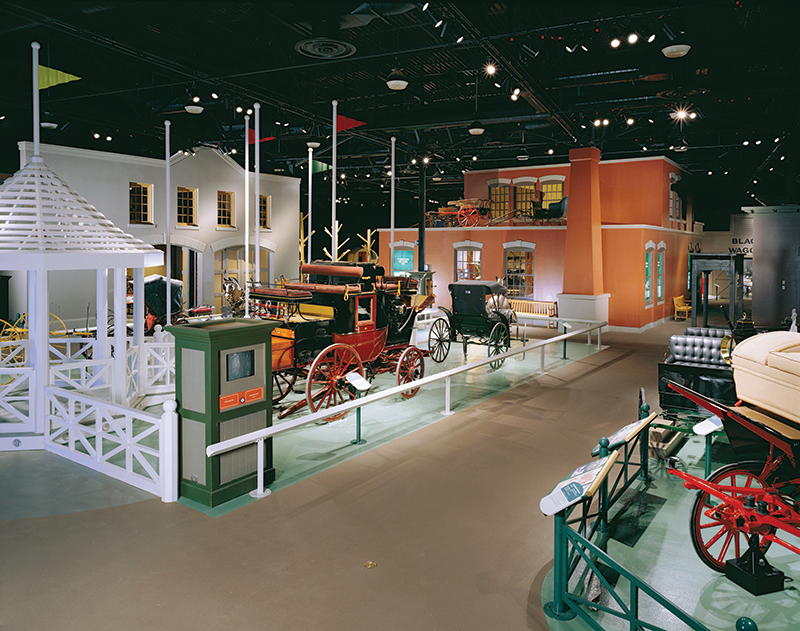
The 63,000 square foot Remington Carriage Centre in Cardston, Alberta, is the largest purpose-built carriage museum in the world, with over 300 carriages on display. Photo courtesy of the Remington Carriage Museum.
Remington earned his wealth from his construction business and his two ranches. Before his day got busy with construction work, building concrete bridges throughout western Canada, he used the early dawn hours to work on carriages. While he felt at home in a business-style suit or a tuxedo, he was more at home in jeans, a plaid shirt, and a battered cowboy hat. He loved physical work and was a proud craftsman with skills in woodworking, painting, metal working, and upholstery. He was, in reality, the working man’s man, never hesitating to shake a hand that was calloused, hard, or dirty from labour. And all the while he retained a wry, distinctive humour.
The pragmatism of the man never failed to surface. Snyder recalls visiting Remington’s home where he noticed one of the first satellite television systems in Cardston. He happened to mention that the price of those installations was dropping. “The problem with waiting is that you might not be alive when the price (finally) comes down,” Remington replied. Snyder says it was one of the hallmarks of the man that he made good use of the present because the future was unknown.
As Remington became more and more passionate about horse-drawn vehicles, Snyder says that his antique vehicles were valued almost as though they were children.
Related: Traditions in Horsemanship
“His first vehicle was a cutter,” he explains. “The second was a Prairie Concord buggy with a folding top and, third an elegant enclosed Brougham, or Clarence, with curved bevelled-glass windows. These three, likely by coincidence, represent the three primary types of non-industrial horse-drawn vehicles: a sleigh, a buggy, and an elegant carriage.”
The cutter was an open sleigh on metal runners made classic by Santa Claus images. The buggy was a Prairie Concord made by the McLaughlin Carriage Company in Oshawa, Ontario. The Prairie Concord was based on the original Concord developed in Concord, New Hampshire in the early 1800s. The original had low sides and side-spring suspension of longitudinal elastic wooden bars. The Prairie version, which had metal semi-elliptical side springs, was an updated version produced almost 100 years later. A buggy whip had a small tasselled tip called a snapper. The Brougham was a light, four-wheeled carriage named after Scottish jurist Lord Brougham. It was designed to his specification in 1838, and it had an enclosed body with two narrow doors. The carriage had a glazed forward window so occupants could see ahead. But it was the Prairie Concord buggy that, Snyder says, evoked a really sharp memory in a visitor to the Museum one day.
“In the spring of 1955, only six months after starting his collection with a cutter to bring Santa into town, Don acquired his second vehicle and first wheeled vehicle, a McLaughlin Prairie Concord, a light buggy with a folding top. He had located it in a barn in Lundbreck, Alberta, almost 100 kilometres from Cardston, where it had been stored for 40 years by that time, suspended from the ceiling by wires. It has now had 100 years of indoor protection since it was last used, and as a consequence we can see the original oilcloth top, original leather dash, and original leather seat. Even at this extremely early time in Don’s collecting career, he recognized that this vehicle was in too good a condition to restore, so he left it unrestored.
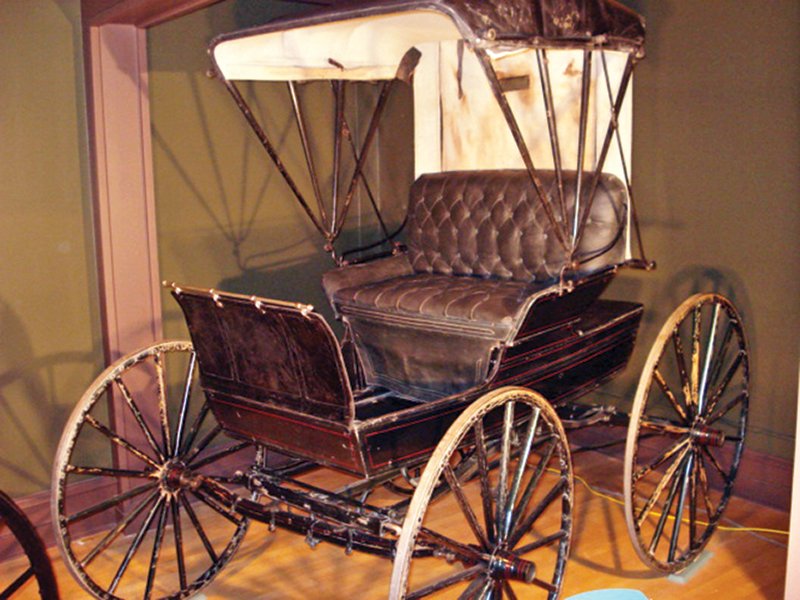
The second vehicle acquired by Remington in 1955 was a Prairie Concord buggy made by McLaughlin in Oshawa, Ontario, with original oilcloth top, leather dash, and leather seat. Photo courtesy of the Remington Carriage Museum.
“In conducting a tour through the collection, I had a visitor say, ‘You mentioned that this vehicle came from Lundbreck. Do you know who owned it?’ I replied that it was owned by the Sandeman family. He responded, ‘My dad worked for the Sandemans, and when I was five years old, he took me out to the barn and showed me this vehicle hanging from the ceiling.’ The visitor was about 50 years old and the sight and recognition of this vehicle brought a rush of memories of his childhood and his father.”
Remington’s devotion to acquiring carriages became a bit of a legend, even to the point of saving marriages. Snyder recalls a time, 50 years ago, when Remington went to Dallas, Texas, to bid on an elegant Brewster Barouche vehicle.
“His main competitor in the bidding was a Texas lawyer named Sid Latham. As the bidding climbed toward $20,000, the auctioneers came down from the stage and gathered around Latham, telling him that he should not allow this vehicle to leave Texas. To uphold the honour of Texas he should increase his bid. Don admonished the auctioneers that such conduct was highly irregular and they returned to the stage. The bidding continued until Don purchased the vehicle for $21,000. As the hammer came down, Sid Latham said in a Texas drawl, ‘Don, I’m so glad you bought that thing. If I had bought it my wife would have divorced me for sure.’ Don replied, ‘I’m glad I got it too, Sid, because if I hadn’t I would have been so miserable my wife would have divorced me too.’ It is now recorded in the Carriage Association of America’s Journal that the sale of that Barouche saved two marriages.”
Remington’s reputation as a carriage collector spread and he frequently received calls from governments, churches, and corporations asking him to provide transportation for dignitaries. In 1973, Queen Elizabeth II and Prince Philip visited Alberta. Remington had been asked by the Government of Alberta’s Protocol Office to provide a five-glass Landau to transport the Queen and the Prince on a tour of the Calgary Stampede. The problem was that no one in the Protocol Office remembered to inform the RCMP.
“When Don and his driver, Jack Bevans, arrived at the Stampede Grounds, they were asked by the RCMP why they were in the area where the Queen’s car was soon to arrive,” says Snyder. “He replied that they were here to carry the Queen and Prince Philip at the request of the Alberta Government. The Police were quite agitated about this situation as they are responsible for security for the Queen. Now, and at any time in the past 30 years, they would have said that it was out of the question. But this was 42 years ago and, although they were not happy, they said, ‘Here’s what we will do. We will provide the driver. We will provide the horses. You and your man can stand at the back of the carriage as footmen.’”
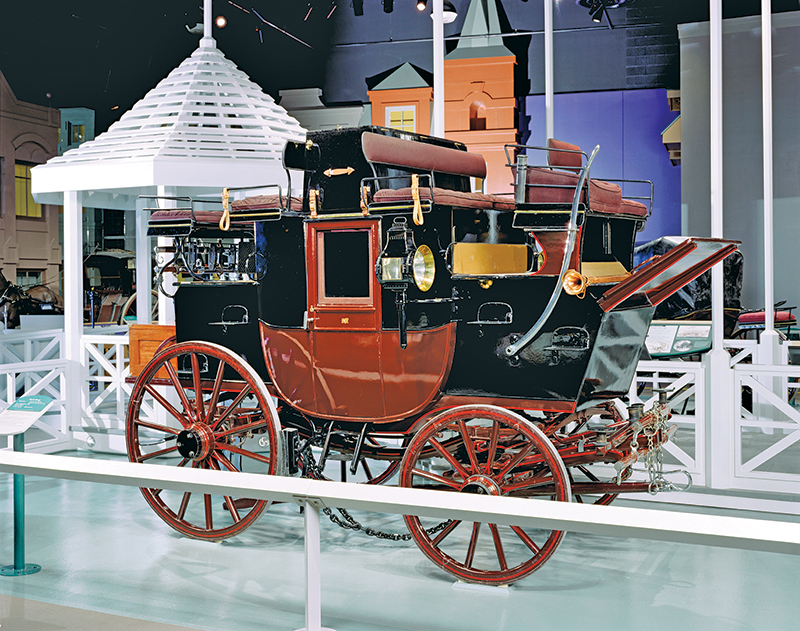
The elegant Brewster Park Drag, made by Brewster & Company in New York. This vehicle was drawn by four horses driven from the rooftop seat, and used for formal outings by passengers who rode in the enclosed comfort of the carriage. Photo courtesy of the Remington Carriage Museum.
Remington was apparently delighted with this arrangement as it allowed him to talk to Prince Philip who, at the time, was President of the FEI and who had been instrumental in developing the sport of combined driving and had overseen the sport’s original set of rules. He had extensive knowledge about carriages.
Related: The Queen's Legacy - A Passion for Horses
During the ride, Prince Philip said to Remington, “This is an interesting vehicle, whose is it?”
“It belongs to me,” Remington replied.
Snyder says that it was likely the only time British royalty had been told that the vehicle they were riding in was owned by their footman!
Landau carriages are a mainstay of ceremonial use. Canada’s State Landau was purchased by Governor General Earl Grey from the Governor General of Australia. The carriage had been built in the 1890s and was gifted by Grey to the King-in-Council in 1911, the year King George V was crowned. It is used for ceremonial processions through Ottawa by the Governor General or visiting members of the Royal Family, and it is maintained by the RCMP.
But a purchase one day at an estate auction in Oregon triggered a life decision for the Remington family.
“Don purchased one of the finest vehicles in the collection at an estate auction in Portland, Oregon,” recalls Snyder. “The Hansom cab had been in the collection of Aaron Frank, one of the founders of the Meyer-Frank department stores in the Pacific Northwest. Don had known Mr. Frank for several years, and his attention was drawn to the estate sale by one of Don’s sons who happened to be in Portland taking training in dermatology. Don attended the sale and bought the Hansom cab which had been owned originally by Alfred Gwynne Vanderbilt of the New York railroad and shipping family. [But] upon arrival back home in Alberta, he was not elated like a kid at Christmas with his new vehicle, which was his normal reaction to a new acquisition. Instead he was depressed, having seen the life avocation of a fellow collector scattered across the continent in a two-day sale. He said to his wife Afton, ‘We can’t let that happen to ours.’ That was the beginning of the idea for the Remington Carriage Museum.”
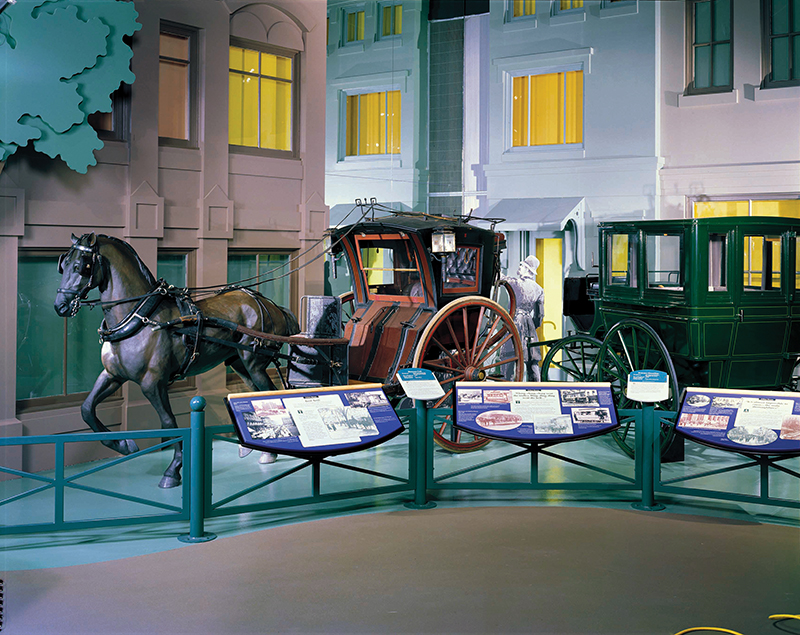
The Hansom Cab at the Remington Carriage Museum was made by Forder and Company in Wolverhampton, England, circa 1870. Photo courtesy of the Remington Carriage Museum
Remington wanted his collection to be kept together after he and Afton were gone; he wanted the collection to be located in Cardston where they lived; and he wanted the vehicles’ stories to be told to anyone who might be interested. The family decided to donate their 48 vehicles, horse herd, extensive harness collection, and a truck and trailer to the Department of Culture, Government of Alberta.
Related: Reviving Ancient Horse Riding Skills
The Remington Carriage Museum opened in 1993, six years after Remington passed away. It is the largest purpose-built carriage museum in the world with the largest collection of carriages (over 300) on display in North America in a town of just 3,500 people. On the museum grounds are stables for a herd of 18 horses – Canadians, Percherons, Quarter Horses, and Percheron/Quarter Horse crosses. The museum is a go-to destination just 40 km from Waterton Lakes National Park, Glacier National Park in Montana, and 60 km from Head Smash-In Buffalo Jump Interpretive Centre.
Inside the $16 million, 63,000 square foot facility many of the carriages are displayed in vignettes that represent how the carriages and coaches were most typically used and in what kind of setting. For instance, there is a mountain scene displaying a stagecoach, a Victorian street scene, a campfire scene with a chuckwagon, and a firehall. Of course, one of the most popular activities at the Museum is to have a ride in a carriage or in the stagecoach around the grounds.
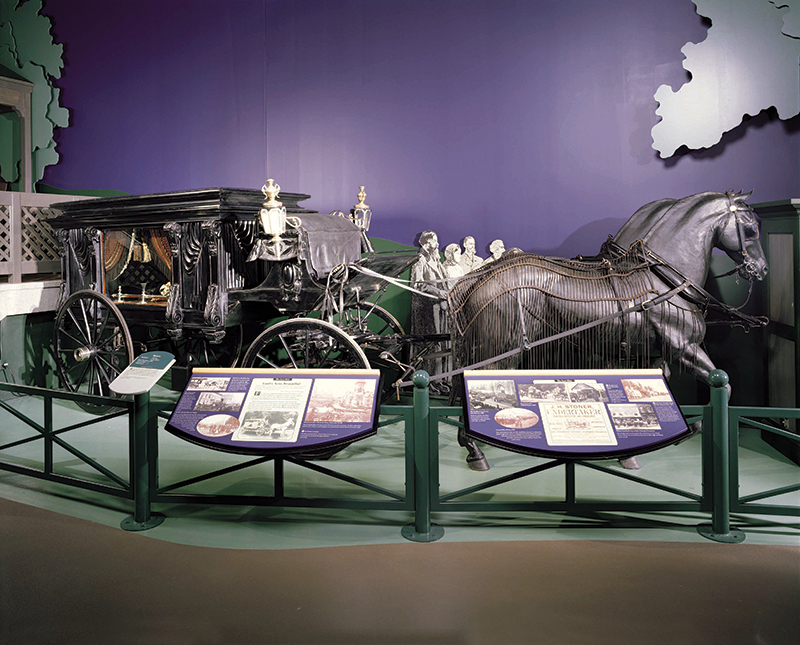
A hearse at the Remington Carriage Centre. Photo courtesy of the Remington Carriage Museum.
Snyder says that the oldest vehicle in the collection is actually the running gear of the wagon that brought the wife of the founder of Cardston (Charles Ora Card) from Cache Valley, Utah, to Alberta in 1887. It was driven by his wife Zina Card and her son Sterling and it dates from approximately 1840.
The most complex carriages on exhibit are the Hansom cab, the Concord stagecoach, the eight-spring barouche, and the park drag. The simplest is the racing sulky. However, according to Snyder, the Concord stagecoach is the most valuable. It is one of only 56 complete vehicles that still remain out of some 10,000 that were built, and is valued at over $500,000.
The first Concord stagecoach was built by wheelwrights J.S. Abbot and Lewis Downing in 1827. At their Concord, New Hampshire wagon factory, they manufactured not only the Concord but 40 other styles of coaches and wagons. But it was the scarlet stagecoach that came to be legendary for the image of passengers travelling across the US to start a new life as the west opened.
In 1857, Wells Fargo joined other express companies to form the Overland Mail Company. It provided financial services and mail delivery by overland stagecoach between St. Louis and San Francisco. Night and day it travelled across the country at a speed anywhere between 5 and 12 miles per hour (8 and 19 km per hour). Today, the company still has 10 original stagecoaches made by Abbot and Downing in their museum displays.
It was Mark Twain who said in his book Roughing It, published in 1872, that the Concord stagecoach’s ride was like an imposing cradle on wheels. The company used braces and a suspension system made of strips of thick bull-hide under the coach to give the ride a swinging motion rather than a jolting up-and-down sensation from a spring-type suspension. Importantly, the suspension system spared the horses from any jarring discomfort.
The stagecoach was pulled by four or six horses, was typically painted scarlet or green, and had canvas or leather curtains hung over the windows. Upholstered bench seats allowed for just nine people to ride inside, and sometimes passengers could ride on top of the coach. Some larger versions of the stagecoach had seating for 12 passengers.
The stagecoach got its name from the fact that the term “stage” referred to the distance between stations along a route so that the coach travelled the entire route in stages. Stops were made for passengers to grab a quick snack of coffee, beef jerky, and biscuits. But the main reason for the staged stops was for a fresh set of horses to be hitched, allowing those that had pulled thus far some time to get rest, feed, and water. The fresh set of horses could then continue the journey to the next stage with the minimum amount of lost time.
The stagecoach at the Remington Carriage Museum is always a highlight among visitors who are thrilled for a chance to climb inside one used by Jackie Chan in Disney’s Shanghai Noon and by Tom Selleck in Crossfire Trail.
Today, visitors number about 30,000 a year, not only from Canada and the US, but the UK, Holland, Germany, China, Australia, and elsewhere. At first, visitors may enter the museum with a fairly casual interest in carriages but by the end of their stay, Snyder says, they are captivated by the information they learn and the stories they hear about life in a bygone age. The carriages come to life and seeing the horses, the harness, the wheels in action only adds to the immediacy of the visit.
“The general public comes here with either low expectations about the interest inherent in carriages, or no expectations at all, so we get a positive ‘bounce’ when they find that there is a fascinating story to be told by horse-drawn vehicles,” says Snyder. “Partly as a consequence of this exceeding-of-expectations, the Remington Carriage Museum for fourteen years in a row was rated number one in the province for visitor satisfaction in the annual (but now discontinued) government-administered surveys at the 19 historic sites and museums owned and operated by the Province of Alberta.”
The vehicles are windows into almost every facet of life a hundred or more years ago, from private family transportation to the moving of commercial goods, from leisure to industry, from fire-fighting to ice delivery – the entire tapestry of life in the nineteenth century is made visible.
Related: The Heritage and Skill of Riding Sidesaddle
The questions visitors to the Centre ask most often are:
Is Don Remington related to Remington the rifle maker? No, nor Remington the artist, the electric razor maker, nor the typewriter maker.
Do you have a stagecoach? Yes, half a dozen.
Do you have a covered wagon? Yes, also half a dozen.
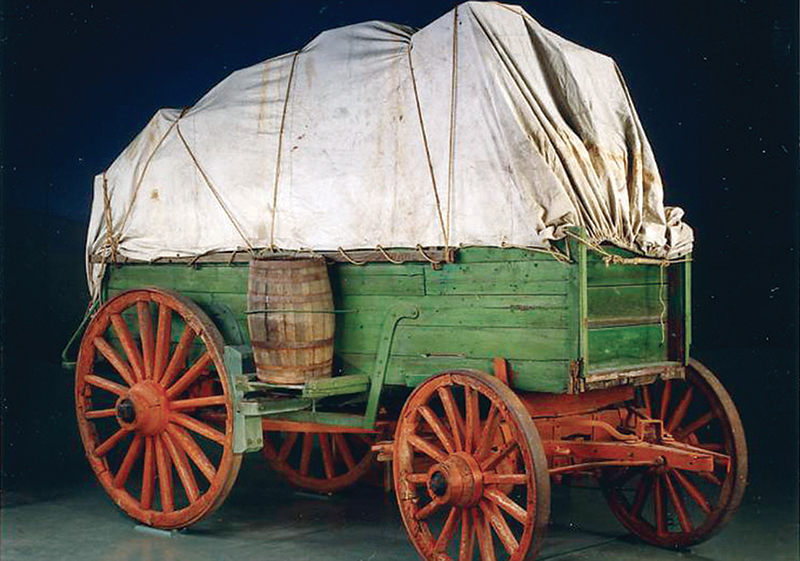
This Bull Wagon (aka Covered Wagon) at the Remington Carriage Centre is the lead Bull Wagon from a wagon train. This particular one was originally used on the Oregon Trail (aka the Whoop-up Trail) and ended its career hauling supplies between Fort Benton, Montana and Fort MacLeod, Alberta. Photo courtesy of the Remington Carriage Museum.
Do you have a milk wagon? No, still looking for a 1998 Studebaker low-boy.
Are you going to restore all of these? No, the ideal is preservation of original materials and workmanship, not restoration.
However, experts at the Museum do restoration work for clients across the western half of North America year-round. Restoration is considered a ‘heritage craft,’ sometimes regrettably called a ‘dying art.’
On the grounds of the Museum is a statue of the Thoroughbred Seabiscuit, America’s beloved racehorse, and George Woolf, the most successful jockey in the 1930s and 1940s. The connection is that Woolf came from Cardston.
“The statue shows Woolf and Seabiscuit in the ‘Race of the Century’ against War Admiral on November 1st, 1938 in Pimlico, Baltimore, Maryland,” says Snyder. “Woolf is looking to his right at Charley Kurtsinger on War Admiral, and saying to the rival jockey ‘So long, Charley!’ as Seabiscuit accelerates around the homestretch turn to win the race by four lengths, setting a track record (1:56 3/5) for the 1 3/16 mile track. This confrontation is considered by many racing experts to be the greatest match-race in history.”
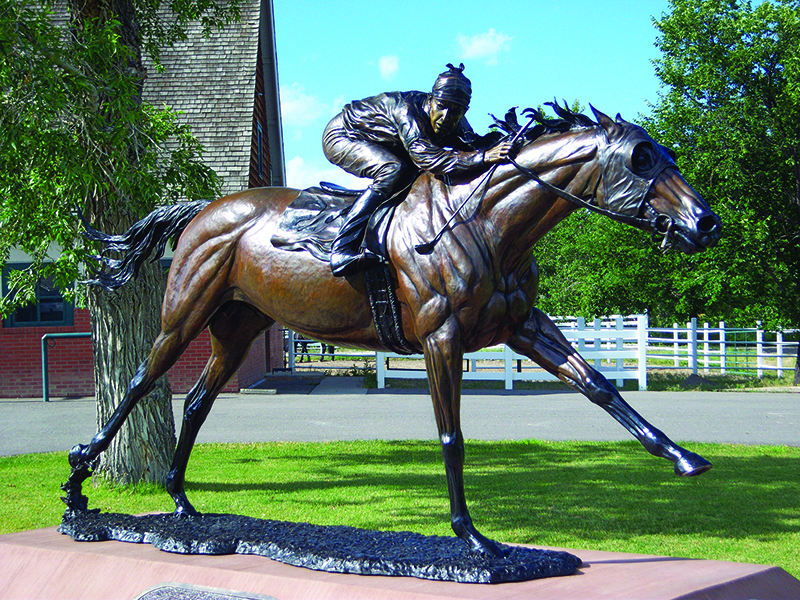
The statue honouring Seabiscuit and jockey George Woolf on the grounds at the Remington Carriage Museum. Woolf was born in Cardston, Alberta, on May 31, 1910. Photo courtesy of the Remington Carriage Museum.
The race was covered by all the radio networks and Remington, 24 years old at the time and starting to build his empire in construction and ranching, must have had an interest in a local boy who made good in the match race of the century.
Horses and the carts and carriages they pulled were the backbone of the early days of Cardston. It would be 16 years before Remington would start his carriage collection, but he had no idea that, just a stone’s throw away, the true heritage of the horse in Cardston lay just beneath the range where cattle then grazed. The area was destined to become St. Mary Reservoir in Cardston County in 1951.
Related: Horse Hooves in History
In dry winters, the water level drops sufficiently to expose the soil. In 1996, a local schoolteacher discovered ancient spear heads and bones. Then in 1998, the reservoir was drained for construction of a new spillway. When wind erosion removed layers of sand and silt, bones and tracks of extinct animals including those of the horse, camel, mammoth, muskox, bison, and caribou, as well as stone tools used by Paleoindians were revealed. The site where so many artifacts were found was once a well-used river crossing in the middle of a vast grassy steppe where many huge herds of grazing animals roamed and, it is believed, hunted by the ancestors of the Clovis people.
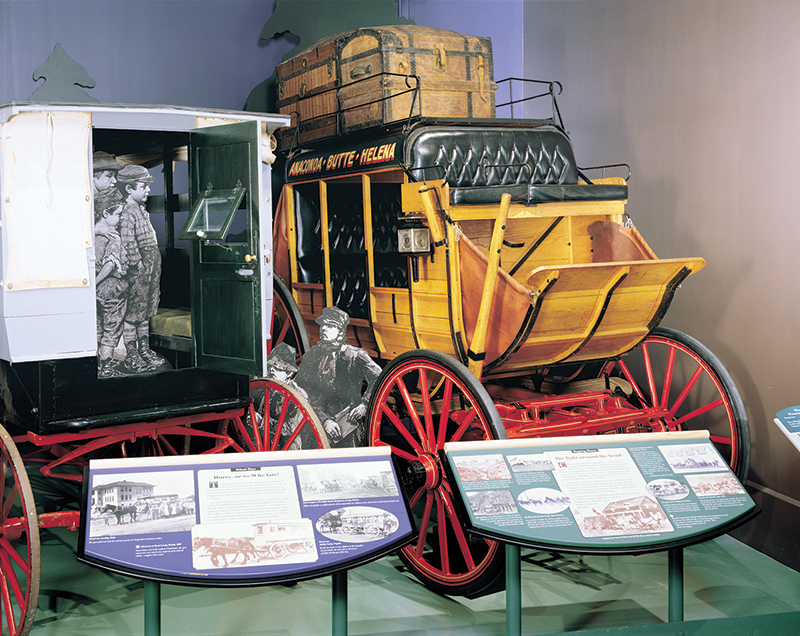
The school wagon (left) is called a School Van or Omnibus. The stagecoach next to the School Van is called a Western Passenger Wagon, also nicknamed the “Mud Wagon” due to conditions often encountered on bad roads. The Western Passenger Wagon, for carrying six passengers inside plus the driver and shotgun, was manufactured by Abbot and Downing in Concord, New Hampshire, the largest manufacturer of stagecoaches in the world. Their stagecoaches, along with the covered wagon, are the most famous horse-drawn vehicles in the world, thanks to their appearance in hundreds of Hollywood Western movies. Photos courtesy of the Remington Carriage Museum.
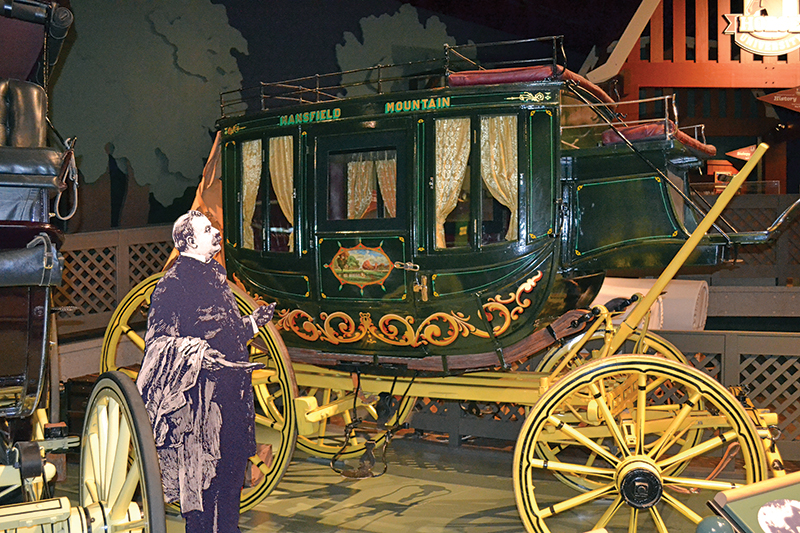
The bigger brother of the Western Passenger Wagon is the Concord Stagecoach, available in two different sizes to carry nine to twelve passengers inside, plus the driver and shotgun. This 1866 coach at Remington Carriage Museum made by Abbot and Downing could carry nine passengers inside and four informally seated on the roof, plus the driver. These “Hotel Coaches” were built to suit the fancy of the purchaser, commonly ordered with custom colours, scrollwork, and landscape paintings on the doors. Interiors were finely appointed and often French windows were used rather than roll-up side curtains. This Concord stagecoach is one of only 56 still remaining out of 10,000 originally built, and is valued at over $500,000. Photo courtesy of Remington Carriage Museum.
Originally, the artifacts were carbon dated to 11,000 years ago. However in 2015, horse, camel, and muskox bones were re-examined and subsequently dated between 13,100 and 13,300 years ago.
Along with many large mammal species, the ancient little horse would disappear from North America where it evolved due mainly to rapid climate change. Over millennia, horses had migrated to Eurasia. When the horse returned to this continent from Europe, it would be in harness pulling the vehicles that defined human civilization and which Don Remington worked so diligently to preserve.
Related: Do Horses Have Hidden, Ancient Toes?
Related: Horses in Hollywood Movies
Main Photo: An original Concord Stagecoach on display at the Wells Fargo History Museum in Old Town San Diego State Historic Park. Photo: Captain Tucker/Wikimedia Commons




